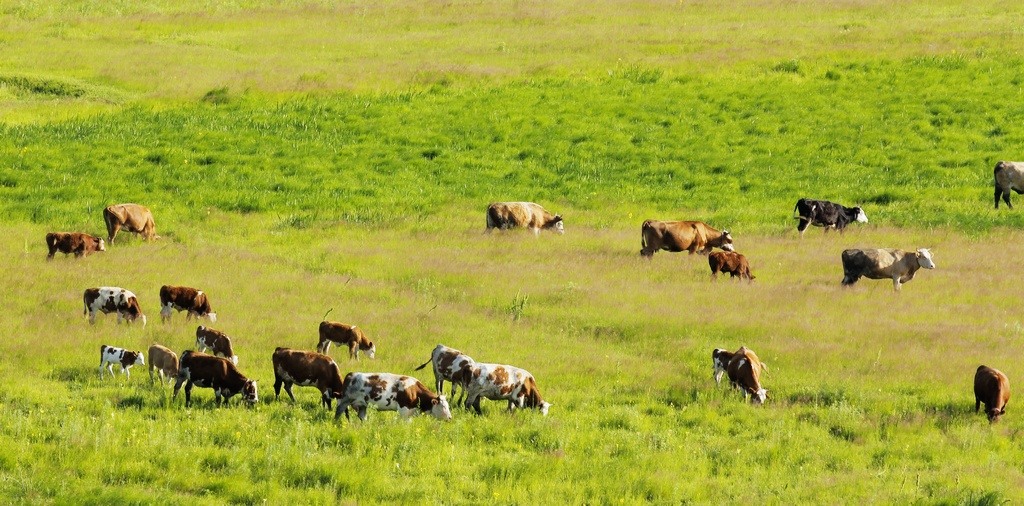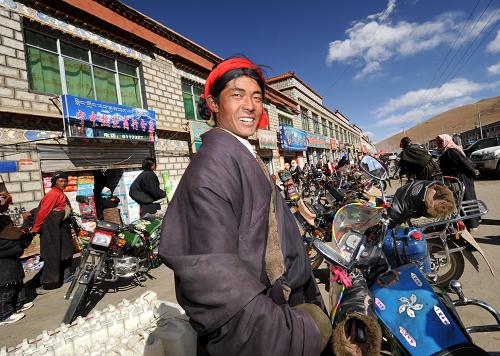Qinghai promotes new livestock model

"In the past people went where the cows and sheep went; yet now the sheep and cows are administered by the 'yak center' and I don’t have to be 'fixed' in the pastures like the ancestors. I have a better life than before, although I have not precisely counted.” said Tsering Dorje a post-80 herder. He now runs a small store in the town of Yuegai.
Tsering Dorje’s hometown is the Chumarle County, Yushu Tibetan Autonomous Prefecture, northwest China's Qinghai province. The Chumarle County is the source of the Yellow river, with an average altitude of 4,500 meters. It is a purely pastoral county and also a state poverty stricken county.
The "yak center" Tsering Dorje referred to is the Zangdi Eco livestock cooperative set up in 2015. This cooperative unifies the grazing and management of all the livestock and meadows of various herder families, distributes the profits by shares by signing trusteeship agreements, so as to help herders to transfer to the tertiary industry.
At present, the cooperative has taken in 45 herder households and more than 100 people and they take 1,500 yaks and 2,282 Tibetan sheep for the cooperative's centralized management and operation.
"Taking livestock into the cooperative is a reasonable investment” said the head of this cooperative, “For the herders, herding a group or a few yaks makes no difference. People herded by experience in the past; now we take rotational grazing in different blocks by integrating the pasture lands. It is not only scientific and reasonable, also avoid various disputes arising from the pasture lands.”
Tsering Dorje said that according to the Risk Prevention& Control Agreement signed with the cooperative, half of the profit from raising livestock of the group can be used as a subsidy for the header households for future usage, if there are any snow disasters or epidemic situations, and the other half belongs to the cooperative.
"In the event that no snow disasters or epidemic situations occurred in a given year, this portion is still an asset belonging to the group and at the end of the year it can be split up as a dividend, so there is nothing to worry about.” he added.
This cooperative has already formed a pastoral management system to undertake rights, responsibilities and profits together. In 2015 after transforming the operations management model, the per capita dividend converted into money was about 5,273 yuan.
Your Comment
Name E-mailRelated News
-
;
-
-

-
Qinghai: Ecological compensation helps herdsmen live in good wealt
For those herdsmen who were born after the 1980s like Gedun Gyatso, becoming an ecology management and protection worker in the Three Rivers Nature Reserve is the thing that he is most proud of.
-
-
-
From herdswoman to white collar: a Tibetan girl's transition
BeforetheopeningoftheQinghai-TibetRailway,Losang,aTibetangirlfromatraditionalherdingfamilyinaremotevillageatthefootofMountNyainqentanglha,neverexpectedherlifetochangemuch.
-
-
-

-
Tibetan farmers and herders' income grows by 12 pct
China's southwestern Tibet region reported 12 percent growth in the per capita disposal income of farmers and herders last year, the local government said Thursday.
-
Based in Lhasa, Tibet Vista is a Tibet travel agency that specialized in Tibet permit, and Tibet tours for both private and group travelers at a local price!
•4 Days Lhasa City Group Tour from USD 460 •8 Days Everest Base Camp Group Tour from USD 850 •15 Days Mt.Kailash Group Tour from USD 1780 •2016 Tibet Train Tours from Beijing, Shanghai, Chengdu, Xining,etc










